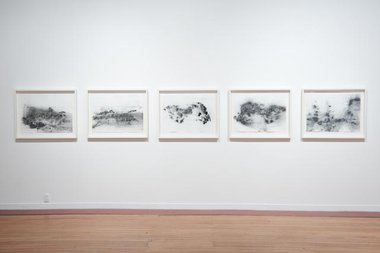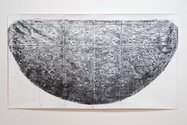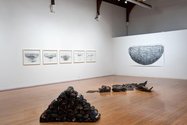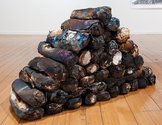Andrew Paul Wood – 21 November, 2009
The drawings refer to the landscape Taylor inhabits, making frequent references to landscape and the geometry of perspective, and show off the versatility of charcoal as a medium. Taylor makes her own from willow, and clearly the materiality of the medium is important to her.
Christchurch
Bronwyn Taylor
From Kaituna to Kaitorete
10 November - 29 November 2009.
Bronwyn Taylor’s exhibition From Kaituna to Kaitorete is essentially a show of charcoal drawings on gessoed paper and some stuff on the floor by way of two installations. I can’t see much point in the latter – if anything they’re rather distracting and not especially interesting – but the drawings are splendid. Gestural and expressive counterpointing harsher geometries, Taylor demonstrates her entitlement to be called a senior artist, having graduated from Canterbury (DipFA) in 1968.
Drawing has been highly underrated for a long time, and yet it is probably the most difficult of all artistic skills to master. I delight in examining good drawing, and although the repetitions and similarities occasionally become a bit monotonous, this is da shizzle. There is a confidence and subtlety, fuelled by a striking earnestness, that requires close up investigation. The titles are specifically geological: Pyroclastic, Plate Motion and Sea Floor Spreading, and Caldera, suggesting an analogy between natural processes like continental drift and erosion, and the making of art, particularly sculpture.It also refers to the volcanic morphology of the artist’s Kaituna Valley home.
Sometimes the lines (expressive even when they are perfectly straight) seem to continue on beyond the paper – a modernist trope in defiance of the classical desire for compositional boundaries. This enhances the illusion of the projected fixed perspectival grid frequently over shadowed by ambiguous forms that may be landscape or even something far less tangible. The vanishing point is likely to be obscured by one of these forms, or else be off the edge of the paper somewhere.
The drawings refer to the landscape Taylor inhabits, making frequent references to landscape and the geometry of perspective, and show off the versatility of charcoal as a medium. Taylor makes her own from willow, and clearly the materiality of the medium is important to her. Understandably Taylor is primarily a sculptor. One of the floor works is a tidy and symmetrical pile of charcoal bundled up in charred and heat-warped tinfoil – no doubt a reference to the manufacture – but that is all it is; a footnote and not a very compelling one.
The other floor work is a sort of Carl André grid of casts taken from the rock face of Kaituna Hill Quarry – and I don’t quite see the point. It’s okay I suppose, indexing the geology, but even by the standards of land art it seems a bit twee and sophomoric in concept, and more than a little out of place when the drawings are so mature and deft. The minimalism of the installations jars with the textural and formal richness of the charcoal. Process as performance, is, I suppose, important to acknowledge, but in this case it’s just not as important as the drawings and should be left out of the picture. The installations simply haven’t got the presence to impact on the viewer’s space and make a point. The drawings do all the talking, and it is self evident that they are charcoal.
Images by Tim Veling for SOFA Gallery. Thank you Coralie




 Advertising in this column
Advertising in this column Two Rooms presents a program of residencies and projects
Two Rooms presents a program of residencies and projects



This Discussion has 0 comments.
Comment
Participate
Register to Participate.
Sign in
Sign in to an existing account.